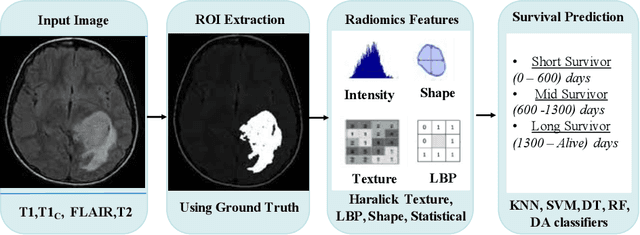Brain Tumor Survival Prediction using Radiomics Features
Paper and Code
Sep 07, 2020



Surgery planning in patients diagnosed with brain tumor is dependent on their survival prognosis. A poor prognosis might demand for a more aggressive treatment and therapy plan, while a favorable prognosis might enable a less risky surgery plan. Thus, accurate survival prognosis is an important step in treatment planning. Recently, deep learning approaches have been used extensively for brain tumor segmentation followed by the use of deep features for prognosis. However, radiomics-based studies have shown more promise using engineered/hand-crafted features. In this paper, we propose a three-step approach for multi-class survival prognosis. In the first stage, we extract image slices corresponding to tumor regions from multiple magnetic resonance image modalities. We then extract radiomic features from these 2D slices. Finally, we train machine learning classifiers to perform the classification. We evaluate our proposed approach on the publicly available BraTS 2019 data and achieve an accuracy of 76.5% and precision of 74.3% using the random forest classifier, which to the best of our knowledge are the highest reported results yet. Further, we identify the most important features that contribute in improving the prediction.
 Add to Chrome
Add to Chrome Add to Firefox
Add to Firefox Add to Edge
Add to Edge